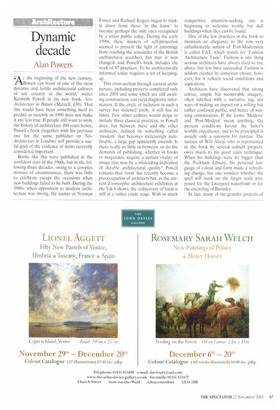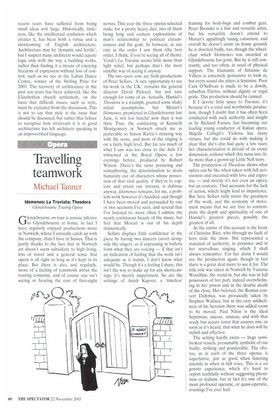Dynamic decade
Alan Powers
t the beginning of the new century,
ritain can boast of one of the most dynamic and fertile architectural cultures of any country in the world,' writes Kenneth Powell in his new book, New Architecture in Britain (Merrell, f30). That this would have been something hard to predict as recently as 1990 does not make it any less true, If people still want to write the history of architecture 100 years hence, Powell's book (together with his previous one for the same publisher on New Architecture in London) will provide a useful part of the evidence of items currently considered important.
Books like this were published in the confident days of the 1960s, but in the following three decades, owing to a complex mixture of circumstances, there was little to celebrate except the occasions when new buildings failed to be built. During the 1980s. when opposition to modern architecture was strong, the names of Norman Foster and Richard Rogers began to trickle down from those in the know' to become perhaps the only ones recognised by a wider public today. During the early 1990s, these masters of self-projection seemed to prevent the light of patronage from reaching the remainder of the British architectural seed-bed, but that is now changed, and Powell's book includes the work of 87 practices. To be architecturally informed today requires a lot of keepingup.
This cross-section through current architecture, including projects completed only since 2001 and some which are still awaiting construction, can yield diagnostic information. If the circle of inclusion in such a survey has widened lately, it still has its limits. Few other authors would deign to include three classical practices, as Powell does, but between these and the other architects, defined by something called 'modern' that becomes increasingly indefinable, a large gap apparently extends. Is there really so little in-between, or do the demands of publishing, whether in books or magazines, require a certain vitality of image that may be a misleading indication of durable architectural quality? Powell remarks that 'form' has recently become a preoccupation of architects but, as the current Zoomorphic architecture exhibition at the V&A shows, the rediscovery of form is still at a rather crude stage. With so much
competitive attention-seeking, one is beginning to welcome worthy but dull buildings when they can be found.
One of the few practices in the book to maintain an allegiance to the now very unfashionable notion of Post-Modernism is called FAT, which stands for 'Fashion Architecture Taste'. Fashion is one thing serious architects have always tried to rise above, but few have succeeded. Fashion is seldom created by conscious choice, however, for it reflects social conditions and aspirations.
Architects have discovered that strong colour, simple but memorable imagery, often labelled with a narrative tag, are ways of making an impact on a willing but rather confused public, and hence of winning commissions. If the terms 'Modern' and 'Post-Modern' mean anything, the present conditions favour the latter's worldly expediency, and to be principled is usually only a synonym for puritan. The success of Will Alsop, who is represented in the book by several unbuilt projects, owes much to his good sales technique. When his buildings were no bigger than the Peckham Library, his personal language of colour and form made a refreshing change, but one wonders whether the spell will work on the larger scale proposed for the Liverpool waterfront or for the encircling of Barnsley.
In fact, many of the grander projects of recent years have suffered from being small ideas writ large. Historically, littleness, like the intellectual confusion which creates it, has been both a virtue and a shortcoming of English architecture. Architecture may be 'dynamic and fertile', but I suspect many architects would equate logic only with the way a building works, rather than finding it a means of enjoying freedom of expression without loss of control, such as we see at the Laban Dance Centre, winner of the Stirling Prize for 2003. The recovery of architecture in the past ten years has been achieved, like the Elizabethan church settlement, on the basis that difficult issues, such as style, must be excluded from the discussion. This is not to say that style is the issue that should be discussed, but rather that failure to recognise how irrelevant it is to good architecture has left architects speaking in an impoverished language.



























































































 Previous page
Previous page